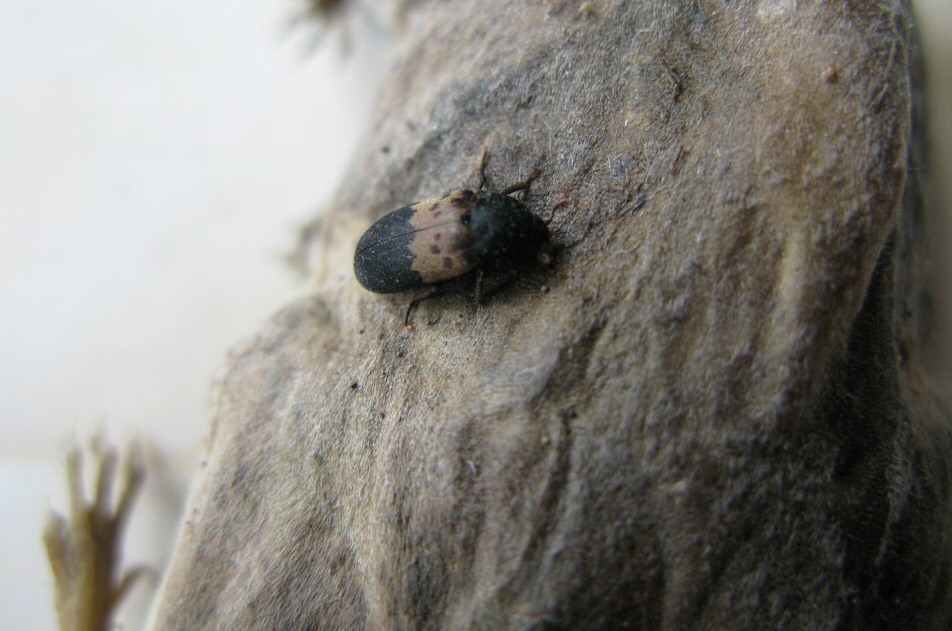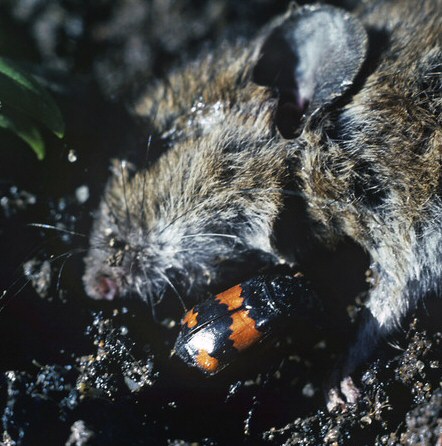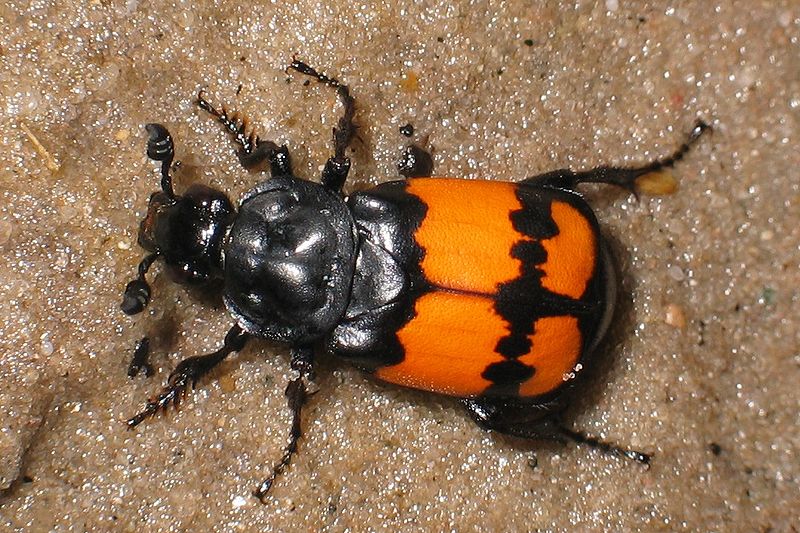- Home
- Garden Wildlife
- Insects
- Beetles
- Carrion beetles
Carrion beetles
Many beetles and other insects are associated with the dead bodies of birds and mammals. The two beetle families most likely to be seen in gardens are the Silphidae, sub family Nicrophorinae, otherwise known as burying beetles, and the Dermestidae or hide beetles.
Species in Britain and Ireland
Seven burying beetles, Nicrophorus species, of the Silphidae family are associated with the corpses of birds and small mammals. They are black beetles, 12-20mm long, and most have distinctive reddish orange coloured bands across their wing cases. Common species are Nicrophorus vespilloides, Nicrophorus investigator and the all-black Nicrophorus humator. Some other members of the Silphidae family, such as Thanatophilus rugosus, also feed on carrion but do not bury the corpses.
Biology
Burying beetles, Nicrophorus species, are attracted by the odour of recently dead small mammals and birds. Males and females work together to bury the corpse by digging out soil from beneath the dead animal, on which they and their larvae will feed. Soil is then pushed over the dead body until it is covered. Considering where they develop, it is not surprising that adult burying beetles have a foul odour. Some other carrion beetles develop as larvae in carcasses but the adults do not bury them.
Hide beetles are attracted to dead animals after the soft tissues have gone and all that remains are decay-resistant parts, such as dry skin, hair and feathers. The larvae of these beetles often develop in the nests of birds and small mammals, where they will find food in the form of hair or feathers incorporated into the nest material, or animals that died in the nest. The adult beetles can sometimes be seen on flowers where they feed on pollen.
Life cycle
When burying beetles have buried a corpse, they create chambers in the soil nearby and stock them with chewed up flesh on which eggs are laid. Nicrophorus species show a high degree of parental care for their offspring, unusual outside the social insects. Both sexes remain with their eggs, and when they hatch, the adults feed the larvae with pre-digested food from the food store. When the larvae have grown larger, they crawl to the corpse and complete their feeding there. The fully fed larvae then burrow into the soil to pupate.
Hide beetles, such as Dermestes and Attagenus species, are attracted to dry animal remains where they lay their eggs. The larvae feed on the hair, fur, dry skin and feathers of dead birds and mammals. Some species, especially of Anthrenus, have larvae that can also feed on dead insects and spiders. When fully fed, the larvae pupate within their last larval skin. Adult hide beetles mainly emerge in spring-early summer.
Role of carrion beetles in gardens
Beetles and larvae that feed on dead animals help to recycle their remains. Other insects, especially fly larvae, also help in this process. In summer, dead birds and mammals can be reduced to skin and bone in just a few weeks. In dry situations, it will take several years before the hair, feathers and dry skin are eaten away by hide beetle larvae.
Other sources of information
Books
Peacock, E. R. (1993) Handbooks for the Identification of British Insects Vol 5 part 3. Adults and larvae of hide, larder
and carpet beetles and their relatives (Coleoptera:Dermestidae) and of Derodontid beetles
(Coleoptera:Derodontidae). – out of print but available as a free download.
By Andrew Halstead reviewed by Andrew Salisbury edited by Steve Head

Nicrophorus investigator on fresh mouse carcase 12-22mm Sexton Beetle Nicrophorus vespilloides 10-18mm
There are 39 hide beetle species recorded in Britain and Ireland, most of which are associated with the dry carcass material that remains after the soft tissues have gone. These include various Anthrenus, Attagenus and Dermestes species. They are 2-11mm long as adults. Their soft-bodied creamy white larvae are often covered with ginger brown hairs and bristles. Some hide beetles are a problem in buildings where the larvae feed on clothes and fabrics made from fur, hair, wool or feathers. They are also a major problem in museums where they damage stuffed animals and insect collections, although under strict quarantine they are also used to clean delicate skeletons.
.jpg)
![Photo: André Karwath aka Aka [CC BY-SA 2.5 (https://creativecommons.org/licenses/by-sa/2.5)], from Wikimedia Commons](images/Anthrenus_verbasci_-_larva_side_(aka).jpg)


Hide beetles.
Top left: Bacon beetle Dermestes lardarius on dry mouse carcass. 8mm long
Top right: Anthrenus verbasci adult 3mm
Right: Anthrenus verbasci larva about 5mm long - this is often found eating carpets and is known as a Carpet Beetle or "Woolly Bear"
Carrion beetles
Many beetles and other insects are associated with the dead bodies of birds and mammals. The two beetle families most likely to be seen in gardens are the Silphidae, sub family Nicrophorinae, otherwise known as burying beetles, and the Dermestidae or hide beetles.
Species in Britain and Ireland
Seven burying beetles, Nicrophorus species, of the Silphidae family are associated with the corpses of birds and small mammals. They are black beetles, 12-20mm long, and most have distinctive reddish orange coloured bands across their wing cases. Common species are Nicrophorus vespilloides, Nicrophorus investigator and the all-black Nicrophorus humator. Some other members of the Silphidae family, such as Thanatophilus rugosus, also feed on carrion but do not bury the corpses.

.jpg)
![Photo: André Karwath aka Aka [CC BY-SA 2.5 (https://creativecommons.org/licenses/by-sa/2.5)], from Wikimedia Commons](images/Anthrenus_verbasci_-_larva_side_(aka).jpg)
Left: Nicrophorus investigator on fresh mouse carcase 12-22mm Right: Sexton Beetle Nicrophorus vespilloides 10-18mm
There are 39 hide beetle species recorded in Britain and Ireland, most of which are associated with the dry carcass material that remains after the soft tissues have gone. These include various Anthrenus, Attagenus and Dermestes species. They are 2-11mm long as adults. Their soft-bodied creamy white larvae are often covered with ginger brown hairs and bristles. Some hide beetles are a problem in buildings where the larvae feed on clothes and fabrics made from fur, hair, wool or feathers. They are also a major problem in museums where they damage stuffed animals and insect collections, although under strict quarantine they are also used to clean delicate skeletons.


Biology
Burying beetles, Nicrophorus species, are attracted by the odour of recently dead small mammals and birds. Males and females work together to bury the corpse by digging out soil from beneath the dead animal, on which they and their larvae will feed. Soil is then pushed over the dead body until it is covered. Considering where they develop, it is not surprising that adult burying beetles have a foul odour. Some other carrion beetles develop as larvae in carcasses but the adults do not bury them.
Hide beetles are attracted to dead animals after the soft tissues have gone and all that remains are decay-resistant parts, such as dry skin, hair and feathers. The larvae of these beetles often develop in the nests of birds and small mammals, where they will find food in the form of hair or feathers incorporated into the nest material, or animals that died in the nest. The adult beetles can sometimes be seen on flowers where they feed on pollen.
Life cycle
When burying beetles have buried a corpse, they create chambers in the soil nearby and stock them with chewed up flesh on which eggs are laid. Nicrophorus species show a high degree of parental care for their offspring, unusual outside the social insects. Both sexes remain with their eggs, and when they hatch, the adults feed the larvae with pre-digested food from the food store. When the larvae have grown larger, they crawl to the corpse and complete their feeding there. The fully fed larvae then burrow into the soil to pupate.
Hide beetles, such as Dermestes and Attagenus species, are attracted to dry animal remains where they lay their eggs. The larvae feed on the hair, fur, dry skin and feathers of dead birds and mammals. Some species, especially of Anthrenus, have larvae that can also feed on dead insects and spiders. When fully fed, the larvae pupate within their last larval skin. Adult hide beetles mainly emerge in spring-early summer.
Role of carrion beetles in gardens
Beetles and larvae that feed on dead animals help to recycle their remains. Other insects, especially fly larvae, also help in this process. In summer, dead birds and mammals can be reduced to skin and bone in just a few weeks. In dry situations, it will take several years before the hair, feathers and dry skin are eaten away by hide beetle larvae.
Other sources of information
Books
Peacock, E. R. (1993) Handbooks for the Identification of British Insects Vol 5 part
3. Adults and larvae of hide, larder and carpet beetles and their relatives (Coleoptera:Dermestidae) and of Derodontid beetles (Coleoptera: Derodontidae) Avalable as free download.
By Andrew Halstead reviewed by Andrew Salisbury edited by Steve Head
Hide beetles. Top: Bacon beetle Dermestes lardarius on dry mouse carcass. 8mm long
Bottom left: Anthrenus verbasci adult 3mm. Bottom right: Anthrenus verbasci larva about 5mm long - this is often found eating carpets and is known as a Carpet Beetle or "Woolly Bear"












